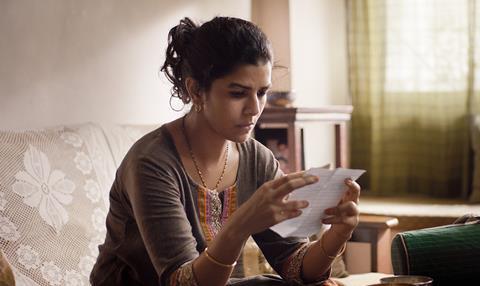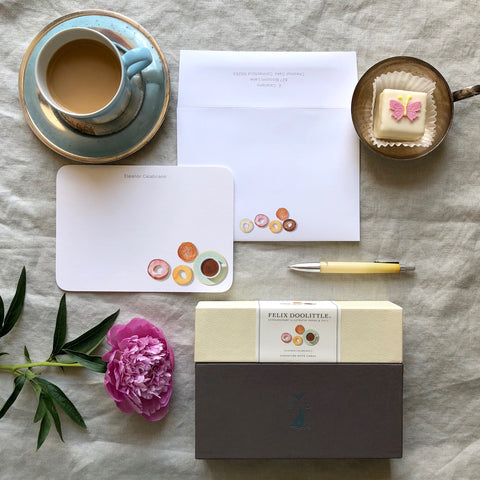- Continue Shopping
- Your Cart is Empty
Write Your Best Letter!

April is National Letter Writing Month - the perfect opportunity to call up Karen Fullerton who has studied the art of letter writing and leads courses on the topic. She gave a love letter writing workshop for a small (but lucky) group at The Paper Mouse. It was eye-opening to see how the attendees came to understand the components of a great letter after Karen read different examples aloud. Many of the participants exclaimed that they wrote the best letter they had ever written that day! Here's a (loosely) transcribed and edited version of our interview and conversation which we hope will inspire you.


Loren Sklar: What do you feel is so special about letter writing? How does it stand out as an art form, as a means of communication that is different than other means of communication?
Karen Fullerton: I've been writing letters ever since I was a child. When I was young, I had a pen pal. When I think of a letter, it is such a gift, truly a gift to the person you're writing to. Nowadays we don't receive many letters, but if a letter is handwritten, it means that the person took that time to be with you in a sense. It's hard to write a cohesive letter without sitting still with that person in your mind. I think that's the most important part. Think about the relationship and let that inform what you write.
Letter writing is the only device for combining solitude with good company. - Lord Byron
LS: Is there any advice you have for people who are going to sit down and write a letter?
KF: My biggest piece of advice is that it doesn't have to be prescribed, and it doesn't have to be perfect. If someone knows you, chances are that they've seen you write something. They'll recognize your handwriting and see aspects of you that they have come to know and appreciate about you. If this is someone you know, it's important to be yourself. Don't worry about cross-outs. Sometimes there are fun things to do with cross-outs. Remember that nobody's perfect.
LS: Sometimes I'll write a draft first, and I know some people write more than one draft. On the one hand, the message and language get refined in the draft process, and on the other hand, is the immediacy and spirit in the handwriting that happens on the first draft. It feels like a deeper representation of who the person is behind the letter - jumbled thoughts, cross-outs and all.
KF: Letter writing used to be more common and because of that, cross-outs were more acceptable. When you write a letter to someone, it has a lot more influence than an email or even a typed letter. It's really personal. Of all the types of communication, the letter makes a difference. People take the time to read a letter in a very different way than they do emails or texts. In my classes, I even discuss how to read a letter. I encourage people to make it an occasion. Make a cup of tea, really look at the envelope and the choices that were made. Make it an event where you really take in all the different elements, the paper, the ink color, the stamp.

Karen Fullerton
To send a letter is a good way to go somewhere without moving anything but your heart. - Phyllis Theroux
LS: It's National Letter Writing Month! Many people are trying to write 30 letters this month, writing a-letter-a-day, or somehow making it to 30 letters by the end of the month. What are your thoughts on this?
KF: It's like anything you want to have a discipline for - people might prescribe that if you do it every day, it becomes part of your habit. I think that's fine for some people. For me, I'd like to think or encourage it to be part of one's life in a more ongoing, less pressured way. Do a little and see the response. See how it makes you feel. Do it periodically as it fits into your schedule.
The problem with a letter-a-day is that it isn't sustainable, it feels that by the end of the month, there's a feeling of conquering something, but it hasn't necessarily been enjoyable. There's a feeling of both accomplishment, or of feeling, "I'm glad I'm done with that." Find or make time in your schedule and take the writing in spurts, feel the benefit and see if it makes you feel good. Hopefully, you can make writing letters a part of your life, year round.
I find there is such joy in knowing that the person is going to receive the letter in a couple of days and have been really present with that person.

LS: What if a person doesn't know what to write?
KF: If you get stuck, stop and relax. Close your eyes a little and breathe. Think about the person and time you shared an experience. Sometimes it's hard to be fresh in what you will write. It's what drew me to develop the course. It's good to start your letter by adding the date and place. Then consider writing about a song that you heard that makes you think of that person, a poem, a story, a walk taken together, your last phone conversation, or something beautiful you saw together. Hone in on your relationship.
At the end of writing the letter, I often do something fun on the envelope, whether it's choosing the right stamp, using pretty tape, or a sticker. A few days later, the thought of them receiving the letter really makes me feel good.
A letter always seemed to me like immortality because it is the mind alone without corporeal friend. - Emily Dickinson
LS: Is the letter an essay with the words, "Dear or Hello so-and-so at the top, or is a letter something truly unique among forms?
KF: There's something about having a pen and pencil in your hand, faced with a blank sheet of paper that produces a different form of writing that happens in a letter. There's a process. Handwriting a letter makes you still. It makes you sensitive. It's like slow-cooking. There's something about that time, that mindfulness, that happens in writing that doesn't necessarily happen on the computer. It's about stepping back, and seeing something and transcribing it onto paper.
LS: Beautifully said! Any additional comments?
KF: Despite the fact that most people will say that they don't write letters, people find the form really beautiful and grounding. The tactile aspect of paper, the marks, the stamps - there's a comfort there. I hope your audience really can share in the pleasure of the handwritten letter.
LS: Thank you so much, Karen, for your time and insights!

Karen's Letter Writing Tips
- Find yourself a card or stationery that would be meaningful (to you or the recipient) to send. (We can help!)
- Gather your favorite pen(s) and whatever supplies you might need. Maybe you'll draw something on the letter?
- Start by writing the date and place.
- Approach the letter as a gift you're giving to the recipient.
- Think about the relationship and let that inform what you write.
- Be yourself.
- Don't worry about trying to be perfect. Cross-outs are ok.
- If you get stuck, stop, relax, and close your eyes. (Writing a letter is a meditation of sorts.)
- Tell a story.
- Speak your heart.
- Continue to enjoy the tactile nature of the paper, the pen gliding over it.
- Add some fun to your letter: a sticker, a great stamp, washi tape, a drawing, a poem, a recipe, a photo.
- Mail the letter.
- A day to a week later, imagine the person receiving your letter. Smile!
Giveaways!
In celebration of National Letter Writing Month, we're having giveaways throughout the month of April on Instagram.
Join us and think lucky!
Instagram - @fxdoolittle
Photo credits
First photo: http://www.tricylereaders.com
Second photo from the fabulous movie: Lunchbox
Second to last photo: Channing Tatum in Dear John
All other photos copyright Felix Doolittle





Loren Sklar
Author